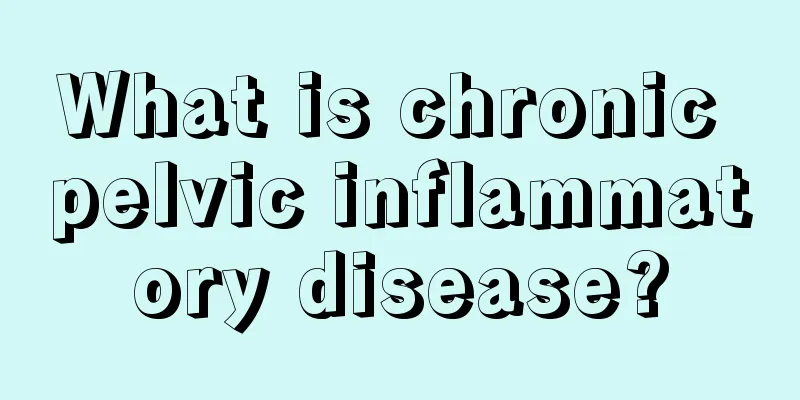What is chronic pelvic inflammatory disease?

|
We all know that pelvic inflammatory disease is a common female disease, but this disease is also divided into acute and chronic. Acute cases may cause acute abdominal pain in patients, while chronic cases are easier to treat. However, this disease is also the most likely to recur, so when undergoing surgical treatment, it must be treated thoroughly. So what is chronic pelvic inflammatory disease? Chronic pelvic inflammatory disease is often caused by incomplete treatment of acute pelvic inflammatory disease, which leads to a prolonged course of the disease in patients with poor physical condition. However, there may be no history of acute pelvic inflammatory disease, such as salpingitis caused by Chlamydia trachomatis infection. Chronic pelvic inflammatory disease is a stubborn disease and can cause acute attacks when the body's resistance is poor. Symptoms and signs 1. Symptoms (1) Chronic pelvic pain: Scar adhesions and pelvic congestion caused by chronic inflammation often cause lower abdominal distension, pain, and lumbar pain. It often worsens after fatigue, sexual intercourse, and before and after menstruation. (2) Infertility and ectopic pregnancy: Adhesion and blockage of the fallopian tubes can cause infertility and ectopic pregnancy. The incidence of infertility after acute pelvic inflammatory disease is 20% to 30%. (3) Menstrual abnormalities: Endometritis often causes irregular menstruation; pelvic congestion can cause increased menstrual flow; and ovarian dysfunction can cause menstrual disorders. (4) Systemic symptoms: Mostly not obvious, sometimes only low-grade fever and fatigue. Due to the long course of the disease, some patients may experience symptoms of neurasthenia, such as lack of energy, general discomfort, insomnia, etc. When the patient's resistance is poor, acute or subacute attacks are likely to occur. 2. Physical signs If it is endometritis, the uterus will be enlarged and tender; if it is salpingitis, the thickened fallopian tubes in the form of cords will be felt on one or both sides of the uterus, and there will be mild tenderness. If it is hydrosalpinx or tubo-ovarian cyst, a cystic tumor will be felt on one or both sides of the pelvic cavity, and movement is often restricted. If it is pelvic connective tissue inflammation, the uterus is often tilted and flexed backward, with limited movement or adhesion and fixation. There are patchy thickening and tenderness on one or both sides of the uterus, and the uterosacral ligaments are often thickened, hardened, and tender. Medication The effect of single therapy for chronic pelvic inflammatory disease is poor, and comprehensive treatment is appropriate based on the location of the lesion, pathological type and patient's complaint. 1. General treatment Relieve patients' mental concerns, increase their confidence in treatment, increase nutrition, exercise, pay attention to the combination of work and rest, and improve the body's resistance. 2. Traditional Chinese medicine treatment Chronic pelvic inflammatory disease is mostly of damp-heat type, and the treatment principle is mainly to clear away heat and dampness, and promote blood circulation and remove blood stasis. Prescription: Salvia miltiorrhiza 18g, red peony root 15g, costusroot 12g, peach kernel 9g, honeysuckle 30g, dandelion 30g, poria 12g, moutan bark 9g, and rehmannia root 9g. If the pain is severe, add 9g of Corydalis yanhusuo. Some patients are of the cold stagnation and qi stagnation type, and the treatment principle is to warm the meridians and dispel the cold, promote qi and activate blood circulation, and Guizhi Fuling Decoction is often used with modifications. For those with qi deficiency, add 15g of Codonopsis pilosula, 9g of Atractylodes macrocephala, and 15g of Astragalus membranaceus. Chinese medicine can be taken orally or by enema. 3. Physical therapy Warmth can promote local blood circulation in the pelvis, improve the nutritional status of tissues, and enhance metabolism, which is beneficial to the absorption and disappearance of inflammation. Commonly used ones include shortwave, ultrashort wave, microwave, laser, iontophoresis (various drugs such as penicillin, streptomycin, etc. can be added), etc. |
<<: What are the dangers of exercising during menstruation?
>>: What are the dangers of occasional sex during menstruation?
Recommend
Night sickness, boy or girl
Morning sickness at night has nothing to do with ...
Why are pregnant women easily misdiagnosed with hepatitis C?
For pregnant women, regular prenatal checkups are...
When is the best time for induction of abortion?
Relevant experts said that induced labor is neces...
Will eating too much popcorn make you get angry? Who is not suitable to eat popcorn?
Popcorn is a puffed food that is very popular amo...
Will eating hawthorn and chestnut together cause gastric stones? Don't worry! People who are prone to gastric stones are...
gossip Recently, hawthorns and chestnuts are avai...
When should I do B-ultrasound when I am pregnant?
Once you are pregnant, you must go to the hospita...
Orthopedic surgeons, what do you think about “the last fracture in your life”?
Orthopedic surgeons have a deep understanding and...
Why do marathons require registration fees? How do marathon runners arrange strength training?
Marathon events are very popular this year, and m...
Pregnancy belly left
After pregnancy, the belly begins to grow slowly,...
Is it okay to do moxibustion during the first month of pregnancy?
When a woman is one month pregnant, the fertilize...
Is it normal for a woman's lower right eyelid to twitch?
What does it look like when a woman's right e...
Is it good to have too much pubic hair?
When it comes to the topic of pubic hair, I belie...
Is kidney deficiency serious for women?
We know that when a person has a mental illness, ...
What causes needle-like pain in breasts?
Nowadays, many women are prone to gynecological d...









